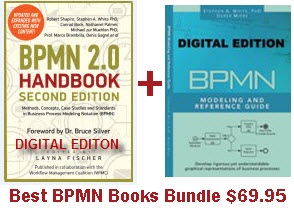 |
Workflow And Reengineering International Association
|
|
|
|
WORKFLOW
COMPARATIVE STUDY
READ MORE ABOUT...
| What's
in this Report?
400 pages of detailed information,
illustrated by some 100 charts, covering:
|
Volume
I Management Summary, in full color
- The changing Workflow Industry: a
summary of the evolution within the workflow industry from the 1999 to
the current edition.
- Workflow Comparison Criteria: detailing
and explaining the importance of the 12 criteria selected for
comparing the products.
- Classes of Workflow Applications: presenting
the four classes of applications - production, administrative,
collaborative and ad-hoc. Each of the product reviewed fits
within these four classes.
- Workflow Product Overview: presents
the results of the analysis of workflow products, with radar
charts giving a one shot view of product position, and a bar chart
relating each product to average scores of all the analyzed
products.

|
| Volume
II, Definition of Workflow Comparison Criteria (full color)
The analysis focuses on 12 criteria
measuring expressive power, complexity ability, and cost of
ownership, for development, deployment and maintenance of workflow
applications.
| Throughput
Rates |
Depends on the
efficiency of the engine, and its capacity to run on top of a
distributed cluster of servers. |
| Procedure
Power |
The capacity of the
procedure development environment to express the real complexity
of procedures in all their smallest details. |
| Activity
Programming |
The API is the
cornerstone of activity programming, with support for deadlines
management, and events mechanisms. |
| Dispatching
and Organization Representation: |
The capability to
dispatch each individual activity to the participant with the
correct level of access rights and appropriate role in the
organization. |
| Operation
and Statistics |
All features that
facilitate operation of the server, and collection and
interpretation of statistics on case processing, including tools
provided to minimize the cost of communications and workstation
administration. |
| Enterprise
Application Integration (EAI) |
Evaluates the tools
provided to take benefits of most modern Enterprise Application
Integration: message queuing, application adapters, COM/DCOM
distributed integration, CORBA support, and two-level transaction
support. |
| Distribution |
Supports co-operation,
within the same company or set of partners, of several
independent workflow engines operated by different departments
(e.g. a manufacturing process that triggers a purchase order
process, and cascades to an Extranet based supply chain process). |
| Internet
Support |
The user interface can
be operated from a simple Web browser. This covers the following
functions: worklist handler, activity execution, graphical
procedure status, and starting a procedure instance. |
| Dynamic
Changes |
Collaborative and ad-hoc
procedures, even if known in advance, must be defined on the
spot. Since they might be incomplete, it is important to be able
to change them dynamically to factor in unforeseen situations. |
| Procedure
Definition |
The best way to shorten
process definition time is to offer a graphical process
definition tool. Further assistance can be provided if the
workflow engine supports additional features like skip,
undo, offered/accepted states, suspend, delegate and reroute. |
| Activity
Definition |
Activity implementation
(no programming) can be achieved by providing embedded support,
libraries of activities, and forms generation tools integrated
with the process definition tool. Additional flexibility can be
provided by a library of basic actions that can be scripted
(possibly graphically) to implement activities. |
| Ready-to-use
agents |
The engine is provided
together with ready-to-use agents. No programming is required to
run defined procedures. This is mandatory for ad-hoc workflow
applications and includes: a worklist handler, and a standard
activity agent for managing the dialogue with the user. |

This bar chart lists product
features related to the
Procedure Power criterion with weights expressed in percentages. Each
product feature is further broken down into characteristics, each being
given an individual score.
|
READ MORE ABOUT...
ORDER
FORM
|
|
| |
|
| |
New Book

BPMN Modeling and Reference Guide

Two Best Sellers - One Special Price!
Retail $114.95 Huge 39% Discount.
Pay only $69.95 for both BPMN
books in one bundle.
You
Save $45.00.
BPMN Edición digital en español
Precio: $49.95
Comprar
|
A Member of:

Copyright © 1993 - 2014
Workflow And Reengineering International Association
All rights reserved.
Last modified:
July 15, 2014
|


